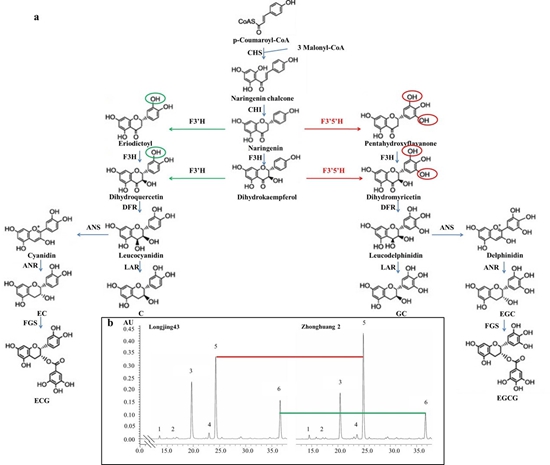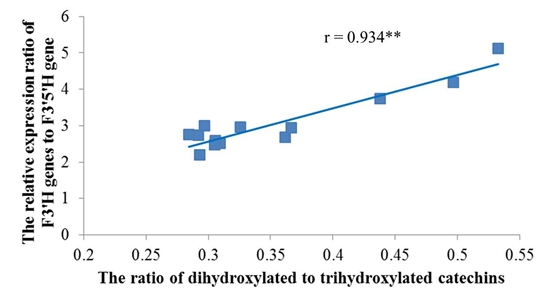分享到
New advance in the regulation system of catechin composition in Camellia sinensis
The ratio of dihydroxylated to trihydroxylated catechins (RDTC) is an important indicator of tea quality and biochemical marker for the study of genetic diversity. It is reported to be under genetic control but the underlying mechanism is not well understood. Flavonoid 3′-hydroxylase (F3′H) and flavonoid 3′,5′-hydroxylase (F3′5′H) are key enzymes involved in the formation of dihydroxylated and trihydroxylated catechins. The transcriptome and HPLC analysis of tea samples from Longjing43 and Zhonghuang2 under control and shading treatment were performed to assess the F3′H and F3′5′H genes that might affect RDTC. Four key F3′H and F3′5′H genes (including CsF3′5′H1, CsF3′H1, CsF3′H2 and CsF3′H3) were identified to be closely correlated with RDTC. Shading treatment had little effect on RDTC, which was attributed to the stable expression of these key F3′H and F3′5′H genes. The correlation of the coexpression of four key genes and RDTC was further confirmed among 13 tea varieties by real time PCR and HPLC analysis.
The current results may establish valuable foundation for further research about the mechanism controlling catechin composition in tea. The results were published in PLoS ONE (DOI: 10.1371/journal.pone.0137925) and this work was supported by the National Natural Science Foundation of China (31470396), the Natural Science Foundation of Zhejiang Province (LY14C020001), the Earmarked Fund for China Agriculture Research System (CARS-23) and the Agricultural Science and Technology Innovation Program (ASTIP) of CAAS.

Fig.1. Catechin biosynthetic pathway and chromatogram of typical tea samples

Fig. 2. Correlation of the relative expression of key F3′H genes to CsF3′5′H1 and the ratio of dihydroxylated to trihydroxylatedcatechins among 13 varieties
The current results may establish valuable foundation for further research about the mechanism controlling catechin composition in tea. The results were published in PLoS ONE (DOI: 10.1371/journal.pone.0137925) and this work was supported by the National Natural Science Foundation of China (31470396), the Natural Science Foundation of Zhejiang Province (LY14C020001), the Earmarked Fund for China Agriculture Research System (CARS-23) and the Agricultural Science and Technology Innovation Program (ASTIP) of CAAS.

Fig.1. Catechin biosynthetic pathway and chromatogram of typical tea samples

Fig. 2. Correlation of the relative expression of key F3′H genes to CsF3′5′H1 and the ratio of dihydroxylated to trihydroxylatedcatechins among 13 varieties
By Wei Kang
weikang@tracaas.cn
weikang@tracaas.cn
Latest News
-
 Apr 18, 2024Opening Ceremony of the Training Workshop on Wheat Head Scab Resistance Breeding and Pest Control in Africa Held in CAAS
Apr 18, 2024Opening Ceremony of the Training Workshop on Wheat Head Scab Resistance Breeding and Pest Control in Africa Held in CAAS -
 Apr 03, 2024IPPCAAS Co-organized the Training Workshop on Management and Application of Biopesticides in Nepal
Apr 03, 2024IPPCAAS Co-organized the Training Workshop on Management and Application of Biopesticides in Nepal -
 Mar 28, 2024Delegation from the School of Agriculture and Food Science of University College Dublin, Ireland Visit to IAS, CAAS
Mar 28, 2024Delegation from the School of Agriculture and Food Science of University College Dublin, Ireland Visit to IAS, CAAS -
 Mar 25, 2024Director of World Food Prize Foundation visited GSCAAS
Mar 25, 2024Director of World Food Prize Foundation visited GSCAAS -
 Mar 20, 2024Institute of Crop Sciences (ICS) and Syngenta Group Global Seeds Advance Collaborative Research in the Seed Industry
Mar 20, 2024Institute of Crop Sciences (ICS) and Syngenta Group Global Seeds Advance Collaborative Research in the Seed Industry
